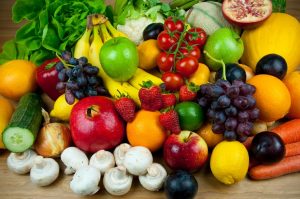
ΑΙhub.org
How sensors and big data can help cut food wastage

By Jean Frederic Isingizwe Nturambirwe, Stellenbosch University and Umezuruike Linus Opara, Stellenbosch University
Modern farming has evolved by adopting technical advances such as machines for ploughing and harvesting, controlled irrigation, fertilisers, pesticides, crop breeding and genetics research. These have helped farmers to produce large crops of a good quality in a fairly predictable way.
But there’s still progress to be made in getting the best possible yields from different kinds of soils. And big losses still occur – especially during and after harvest – where monitoring and handling of produce isn’t done well. The industry needs smart and precise solutions and these are becoming available through new technology.
Smart farming aims to use modern technology to improve yield and product quality. One example is precision agriculture, a site specific crop management concept that uses a decision support system based on monitoring, measuring and responding to inter and intra-field variability in crops. This allows farmers to optimise their returns and preserve resources. Such monitoring solutions can be achieved by integrating electronic sensing devices that record data in soil, the environment or crops. The data can then provide useful information for decision-making, through a process called data analytics.
The goal is to make the best possible use of soil in a particular field, control crop care and make informed decisions about handling produce after harvest.
We’ve been involved in the development and use of sensors to help establish the quality of a wide range of horticultural products, including fruits. We used computer intelligence methods to detect defects and predict the quality of fruit.
Our latest research found that data-driven solutions have a number of benefits. For instance, they can help reduce the loss of fruit and vegetables along the supply chain from farm to being consumed.
The problem
Fruits and vegetables can be damaged before, during and after harvest as well as in storage. This is wasteful. Some decay and spoilage is caused by viruses, fungi, bacteria or microbial pathogens. Products that are tightly packed or bruised are more vulnerable to infections and don’t last as long.
According to the United Nations Food and Agriculture Organisation, around 14% of the world’s food is lost after harvest and before reaching shops and markets. And about one-third of the world’s food is lost or wasted. Minimising food loss and waste is critical to creating a Zero Hunger world where more than 821 million people are already suffering from hunger.
Our research involved reviewing the role that data analytics can play in the detection of defects in fruit and vegetables. We found that machine learning – the ability of computers to find patterns in data, make predictions and propose decisions without being explicitly programmed – far surpasses traditional methods for classifying produce.
Machine learning has made great achievements in detecting plant diseases and fruit. These could be extended to monitoring the quality of fruit and other foods. Sensors can be used to detect insects and diseases in fruits and vegetables, acting as electronic noses or tongues and measuring chemical composition. They can also measure physical properties, such as firmness and acidity, to determine product quality.
The products’ acceptability depends on colour, shape, size, sweetness, and not having defects such as bruises and insect infestations. This is important for customer satisfaction and for the returns that producers and suppliers make.
Sensing devices can supply data about these characteristics to computer algorithms for analysis. These new developments in machine learning allow for fast and effective quality determination and prediction in fresh produce.
For example, imaging techniques have been coupled with machine learning algorithms to detect bruises, cold injury and browning in fruit such as apples, pears and citrus, and to detect various defects in tomatoes. Smartphone-based applications are being developed for use in quality recognition for small berry fruits.
Machine learning reduces losses
There’s a current global research trend aimed at integrating sensing devices along the food chain to continuously monitor and control the quality indicators. We reviewed this research and found stages where such solutions are used in the food chain. These include:
-
Crop monitoring
Sensors can be used to measure properties of fruit and vegetables while they are growing, such as colour, size and shape. Such information helps control the growth conditions, such as water supply, and accurately determines the best harvest date. This reduces losses at harvest. For example, some smallholder farmers in Germany have been using smartphones to check the quality of their crops by sending crop images to be processed by experts through machine learning models; feedback is then sent to the farmers. Companies are developing models to track environmental factors such as weather changes and predict how these factors affect crop yield. This kind of support is aimed particularly at farmers in developing countries.
-
Post-harvest quality monitoring
In packhouses, products must be graded and sorted according to quality standards to determine their suitability for different consumer destinations. Export products need to keep well during long distance transport and on the shelf.
For local markets, where travel time is shorter, the quality requirements could be of a different standard. To determine whether a product is suitable for animal feed or human consumption, specialised sensors take measurements and generate data to classify, grade and sort the products into categories.
-
Market quality monitoring
Sensors can even be integrated into packaging materials that continuously monitor and report on the status of the product in real time. These sensors can be enabled to communicate and send data to a centre of command. Monitoring, detecting and segregating food products like fresh fruit to classify and remove unsafe products to meet market demand is crucial to ensure profitability and maintain market share.
With the increasing world population, which is expected to exceed 9 billion by 2050, food and nutrition security is set to become an even bigger challenge, especially in sub-Saharan Africa. Data-driven automation can contribute to the solution.![]()
Jean Frederic Isingizwe Nturambirwe, Postdoctoral research fellow at the Research Laboratory for Postharvest Technology / SARChI, Stellenbosch University and Umezuruike Linus Opara, Distinguished Professor and DST-NRF South African Chair in Postharvest Technology, Stellenbosch University
This article is republished from The Conversation under a Creative Commons license. Read the original article.
Read the authors’ full review article: Machine learning applications to non-destructive defect detection in horticultural products.










